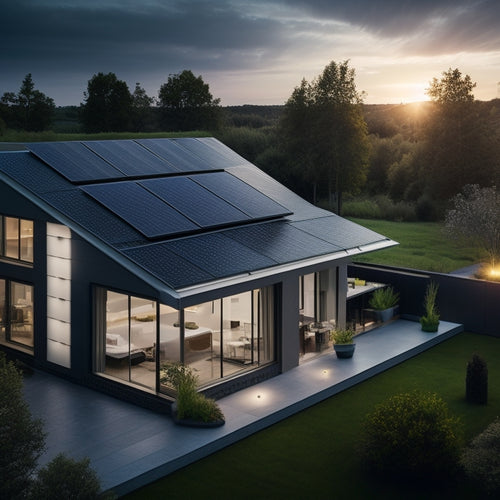
3 Essential Backup Power System Design Tips
Share
When designing a backup power system, you'll want to get three vital elements right. First, accurately assess your energy needs by conducting a thorough load calculation and identifying critical loads like lighting and HVAC systems. Next, choose the right battery configuration, considering the trade-offs between lithium-ion's longer cycle life and lead acid's cost-effectiveness. Finally, correctly size your solar array by evaluating panel efficiency, orientation, and roof space to guarantee consistent energy flow. By focusing on these essential factors, you'll be well on your way to creating a reliable backup power system that meets your unique needs - and there's more to investigate.
Overview
- Conduct a thorough load calculation to identify critical loads and optimize system design, reducing waste and minimizing costs.
- Choose the right battery configuration, weighing trade-offs between lithium-ion's longer cycle life and lead acid's cost-effectiveness.
- Size the solar array correctly, balancing high-efficiency panels with cost considerations and ideal installation factors like orientation and tilt.
- Upgrade to energy-efficient appliances to reduce the total power load and ensure accurate system sizing.
- Ensure the backup power system aligns with unique energy needs, prioritizing critical loads like lighting, HVAC, and IT systems.
Assessing Energy Needs Accurately
Your facility's backup power system must be designed to meet its unique energy needs, which requires a precise assessment of its power requirements.
You must conduct a thorough load calculation to determine the total power load that your system needs to support. This involves identifying all the critical loads, such as lighting, HVAC, and IT systems, and calculating their individual power requirements.
To guarantee energy efficiency, focus on energy-efficient appliances and consider upgrading to energy-efficient appliances. By doing so, you can assure that your backup power system is sized correctly to provide the necessary energy efficiency and reliability.
Additionally, an accurate load calculation helps you optimize your system's design, reducing energy waste and minimizing costs.
Selecting Right Battery Configuration
With a precise load calculation in hand, you're ready to design a backup power system that meets your facility's unique energy needs. Now, it's time to select the right battery configuration. This vital step guarantees your system provides reliable power during outages. When choosing between lithium-ion and lead acid batteries, consider the key differences:
| Battery Type | Cycle Life | Depth of Discharge |
|---|---|---|
| Lithium-Ion | 3,000 - 5,000 cycles | 80% |
| Lead Acid | 200 - 500 cycles | 50% |
| Hybrid | 1,000 - 2,000 cycles | 60% |
Lithium-ion batteries offer advantages like longer cycle life and higher depth of discharge, making them ideal for frequent or deep discharge applications. In contrast, lead acid batteries are more cost-effective but require more maintenance. Consider your facility's specific needs and weigh the trade-offs before making a decision.
Sizing Solar Array Correctly
The solar array is a critical component of a backup power system, as it directly impacts the system's ability to recharge the batteries and provide power during an outage.
When sizing your solar array, you'll need to evaluate factors like solar panel efficiency, installation orientation, and available roof space. A higher-efficiency panel may allow for a smaller array, but it'll also increase upfront costs.
To guarantee a reliable power supply, it's important to design a system with high-efficiency panels that can provide a consistent energy flow. Additionally, reflecting on the overall energy efficiency of the system can help minimize losses and enhance independence from fossil fuels.
You'll need to strike a balance between efficiency and cost. Additionally, assess the installation orientation - a south-facing array with a tilt between 30-40 degrees is usually ideal.
Frequently Asked Questions
What Is the Ideal Location for a Backup Power System Installation?
When deciding where to install your backup power system, you'll want to weigh outdoor placement, which offers easy maintenance and natural cooling, against indoor installation, which provides added security and protection from the elements.
How Often Should Backup Power System Maintenance Be Performed?
You're wondering how often to maintain your backup power system. Research suggests that regular maintenance frequency is essential; perform preventive checks every 3-6 months to guarantee reliability, and annually for a thorough inspection to avert unexpected failures.
Can a Backup Power System Be Installed in an Existing Building?
You can install a backup power system in an existing building by exploring retrofitting options that guarantee system compatibility, which may involve upgrading electrical infrastructure, modifying building layouts, or selecting compact systems that fit your space constraints.
What Type of Monitoring Is Required for a Backup Power System?
You'll need to implement power system monitoring to track your backup system's performance, ensuring it's always ready to kick in when the grid fails, providing you with real-time data to optimize its operation and minimize downtime.
Are There Any Specific Safety Considerations for Backup Power Systems?
"An ounce of prevention is worth a pound of cure." When designing backup power systems, you must prioritize safety, ensuring compliance with safety regulations and conducting thorough risk assessments to mitigate potential hazards, guaranteeing reliable and secure power supply.
Ready to Buy
You've got a backup power system design that's customized to your specific needs. By accurately evaluating your energy needs, selecting the right battery configuration, and sizing your solar array correctly, you've guaranteed a reliable and efficient system. Did you know that a single minute of downtime can cost a business up to $5,600? A well-designed backup power system can prevent such losses, providing peace of mind and protecting your bottom line.
Related Posts
-

Sustainable and Eco-Friendly Generators for a Reduced Carbon Footprint
Sustainable and eco-friendly generators are perfect for cutting your carbon footprint and increasing energy efficienc...
-

Advantages of Solar Generating Systems Over Traditional Energy
Solar generating systems provide several key advantages over traditional energy sources. You'll experience lower long...
-

Home Solar Battery
You're opting for a home solar battery that allows you to utilize the power of the sun during the day and use it at n...


